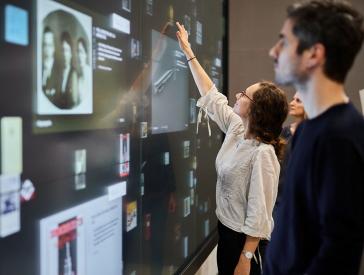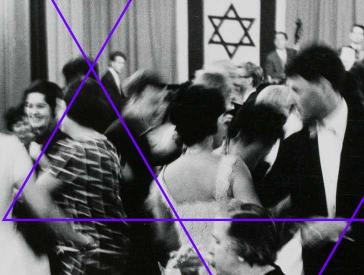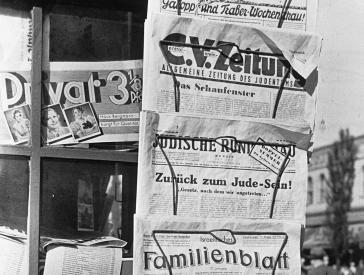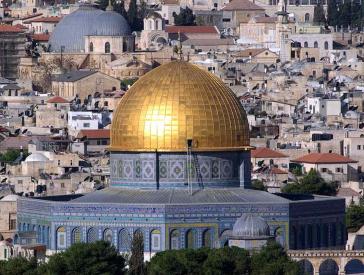Welcome to Jerusalem at the Jewish Museum Berlin
Major Themed Exhibition from 11 December 2017 to 30 April 2019
Press Release, Fri 8 Dec 2017
December 10, the Jewish Museum Berlin opens the major exhibition Welcome to Jerusalem. The 1000 m² exhibition explores aspects of the city’s history, in which religion, politics, and everyday life are inextricably interlinked.
„As the focal point of three monotheistic religions and their irreconcilable aspirations, Jerusalem has been a locus of religious and political tension for many centuries. That was strongly is underlined once again by the US President’s decision to recognize Jerusalem as the capital of Israel. Our exhibition does not aim to offer solutions, but we hope it will generate an understanding of Jerusalem’s special situation and help visitors to form their own minds“
says Peter Schäfer, Director of the Jewish Museum Berlin.
When the exhibition opens in the Old Building today, the permanent exhibition in the Jewish Museum Berlin’s Libeskind Building will close until 2019. A newly designed permanent exhibition will open in the course of 2019.
- Kontakt und Akkreditierung
-
Press office
T +49 (0)30 259 93 419
presse@jmberlin.de
- Address
Jewish Museum Berlin Foundation
Lindenstraße 9–14
10969 Berlin
The exhibition Welcome to Jerusalem tells the history of Jerusalem from Herod’s time until the present day through a selection of themes. Ten rooms present Jerusalem’s many and diverse challenges through historical objects, artistic responses, and multimedia installations. Visitors will find objects that illuminate cultural history, with loans from private collections and international museums – including the Victoria & Albert Museum, Tate Modern, the Musée du Quai Branly, the Uffizi Gallery, and the Israel Museum – as well as works by contemporary artists.
The exhibition’s central axis presents models of the sacred buildings of the three monotheistic religions, sites that have attracted pilgrims and tourists for around two thousand years. The historical models of the Church of the Holy Sepulchre and the Muslim sacred precinct, the Haram esh-Sharif, are complemented by a specially commissioned 1:75 scale model of the Western Wall, made by Dieter Cöllen on the basis of historical findings and measurements. Large-scale projections from the film 24h Jerusalem locate the models in the context of present-day flows of pilgrims and tourists.
Exhibition highlights
One rare loan is the detailed model of the Muslim sacred precinct, the Haram esh-Sharif, with the Dome of the Rock and the Al-Aqsa Mosque. Only three copies of this model, by Conrad Schick, exist worldwide; the one shown in the exhibition comes from the Biblical Museum in Amsterdam. The historically valuable plaster cast of the relief in the Arch of Titus in Rome, showing the spoils of Jerusalem, has been loaned by the University of Leipzig’s Museum of Antiquities. The relief is probably the oldest portrayal of the looted ritual objects after the Temple’s destruction in 70 CE.
The multimedia installation Augmented Temple, created specially for the exhibition, helps visitors to understand the architecture and function of Herod’s Temple in ancient times. The streams of visitors to the Temple – tens of thousands came on the high holidays – are projected onto a 2 m2 model, and the temple’s architecture is explained. In addition, visitors can watch rituals from temple life, one in each of four augmented reality films. The exhibition expands its vision to present-day Jerusalem through works by contemporary artists.
Multimedia installations and films
In cooperation with zero one film, a filmic path through the exhibition was created using images from the documentary 24h Jerusalem, directed by Volker Heise and produced by Thomas Kufus (2014). In a film lounge, visitors can also watch this real-time documentation in its entirety. In this way, the exhibition sustains a constant mirroring between Jerusalem’s history and culture and present-day life in the city.
Another multimedia installation, Conflict, is a powerful 20-minute compilation of historical images and commentaries on the Middle East conflict as exemplified by Jerusalem from 1917 to the present day. Documentary film material on the theme „Pious Protests“ presents the examples of three Jewish groups whose religious practices often lead to conflicts with other secular and religious groupings and with the state: a minority of several thousand ultra-Orthodox Jews who reject certain aspects of the modern state of Israel as sacrilegious; the Women of the Wall, who call for a practice of egalitarian prayer at the Western Wall; and the Temple movements, whose members aim to build a third Jewish Temple on the Temple Mount.
The 1896 film footage shot by the Lumière brothers, shown in the room „Both Sides of the City Wall“, is the very first cinematographic record of Jerusalem. It documents the Ottoman city before the outbreak of the great conflicts.
Contemporary artists
Two rooms in the exhibition present works by contemporary artists. The theme of the film Inferno, by Israeli multimedia artist Yael Bartana, is the rebuilding of Solomon’s Temple. In the conceptual artwork Present Tense, Palestinian-British artist Mona Hatoum addresses the remapping of Palestine after the Oslo Accords. Jerusalem, Jerusalem by Gustav Metzger is taken from the series Historic Photographs, which Metzger agreed to lend a few months before his death. In the last room, a changing selection of video art will be on show for the duration of the exhibition. International news reports on Jerusalem will be pinned to a long bulletin board and continually updated until the exhibition ends. Over those sixteen months, the collection will become a chronicle of current events in Jerusalem.
| Exhibition dates | 11 December 2017 to 30 April 2019 |
|---|---|
| Location | Old Building, Level 1 |
| Admission | With the museum ticket (8 €, reduced 3 euros) |
| Opening hours | Daily, 10 am to 8 pm |
The accompanying program will be presented at the press conference.
The catalog Welcome to Jerusalem, edited by Margret Kampmeyer and Cilly Kugelmann, is published by Wienand Verlag, Cologne, for the Jewish Museum Berlin (264 pages, 155 illustrations, softbound, available in English or German, retail price €39.90, museum price €29.90).
Supported by the Federal Government Commissioner for Culture and the Media.
With the kind support of LOTTO-Stiftung.
The exhibition’s accompanying program is supported by Siemens AG.
Media partners
Wall, ARTE, rbb Inforadio, Yorck Kinogruppe, zitty Berlin
Press Photos
Free to use for current reporting, provided the listed image captions and copyright details are included.






